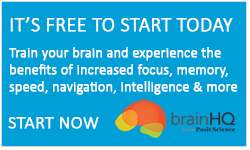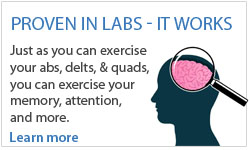BrainHQ exercises and assessments have been rigorously tested and scientifically proven to be beneficial in hundreds of independent, peer-reviewed research papers published in scientific journals—and many more studies are underway.
BrainHQ has been shown to bring significant improvements in each of these categories:
Processing Speed
Many of the BrainHQ exercises are designed to increase processing speed—how quickly (and accurately)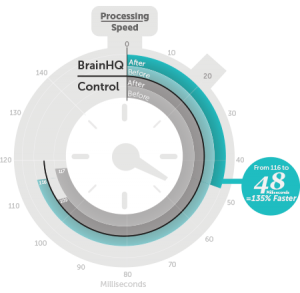 the brain can process information coming in from vision and hearing. To date, 25 scientific papers have shown faster processing after training with BrainHQ exercises. This includes the ACTIVE study, one of the largest and most respected studies ever conducted on brain training in adults. Among other things, individual studies have shown:
the brain can process information coming in from vision and hearing. To date, 25 scientific papers have shown faster processing after training with BrainHQ exercises. This includes the ACTIVE study, one of the largest and most respected studies ever conducted on brain training in adults. Among other things, individual studies have shown:
 An average increase in auditory processing speed of 135%
An average increase in auditory processing speed of 135% A doubling, on average, in visual processing speed, with some benefit of training still evident at 5- and 10-year follow-ups
A doubling, on average, in visual processing speed, with some benefit of training still evident at 5- and 10-year follow-ups A partial reversal of age-related neural slowing and an improvement in temporal precision, as measured through brain imaging
A partial reversal of age-related neural slowing and an improvement in temporal precision, as measured through brain imaging
Memory
Having a good memory is a key part of strong cognitive function. Fifteen scientific papers have measured memory performance in people before and after using 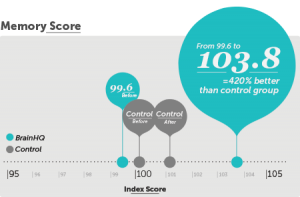 BrainHQ exercises. Among other things, researchers have shown:
BrainHQ exercises. Among other things, researchers have shown:
 An average improvement of 10 years in memory
An average improvement of 10 years in memory “Generalization” beyond trained tasks to standard memory tests
“Generalization” beyond trained tasks to standard memory tests Increased activity in areas of the brain associated with memory
Increased activity in areas of the brain associated with memory
Attention
The ability to appropriately focus your attention is very important to feeling sharp. Not only do you have to pay close attention to what matters to you; it’s equally important to be able to filter out the distractions. Six published papers have shown that training with BrainHQ exercises can hone attentional focus including:
 Significantly changing brain behaviour in ways that improve selective visual attention
Significantly changing brain behaviour in ways that improve selective visual attention Driving improvements in people’s ability to notice targets in their peripheral vision
Driving improvements in people’s ability to notice targets in their peripheral vision
Everyday Cognition
A common question is: Does BrainHQ brain training make things easier or better in everyday life, or does it just “teach to the test”? In addition to improvements in memory and other key skills, BrainHQ training has now been shown in 11 published research papers to help people perform activities of daily living more efficiently and accurately - and they notice. Among other things, studies have shown:
 People perform better on tests of “instrumental activities of daily living” – they can do tasks (such as handling money and medications) more quickly after training than before.
People perform better on tests of “instrumental activities of daily living” – they can do tasks (such as handling money and medications) more quickly after training than before. People feel more capable in daily activities—things like remembering a shopping list, hearing better in crowded places, and more.
People feel more capable in daily activities—things like remembering a shopping list, hearing better in crowded places, and more.
Vision and Hearing
Many people think vision depends on the eyes, and hearing on the ears. That ’s only partly true. The brain is responsible for processing what their eyes and ears take in. Training with BrainHQ exercises has been shown to:
 Improve the ability to hear in noisy or crowded places
Improve the ability to hear in noisy or crowded places Enhance accuracy and attention in vision and hearing
Enhance accuracy and attention in vision and hearing
Physical Brain Change
Training to improve performance is a good thing, but does it actually change the brain? In twelve imaging studies (including fMRI and EEG), researchers have measured changes in the brain itself after training with BrainHQ. Among other things, they have shown that BrainHQ training can:
 Speed up neural responses to speech and other sensory information
Speed up neural responses to speech and other sensory information Increase white matter in the attention network of the brain
Increase white matter in the attention network of the brain Increase activation in brain areas associated with attention
Increase activation in brain areas associated with attention
Mood
Four research papers have examined the effects of using a BrainHQ exercise on a person’s mood. These have shown that people who used that exercise:
 Felt more confident, happier and in better control over their lives
Felt more confident, happier and in better control over their lives Were less likely to experience the onset of or an increase in depressive symptoms
Were less likely to experience the onset of or an increase in depressive symptoms
Health-Related Quality of Life
Better brain fitness can lead to a better and healthier quality of life. Several studies have shown that using BrainHQ exercises can help protect health over time and that was reflected in lower medical costs. Among other things, they have shown that:
 People who used a BrainHQ exercise were protected against declines in health-related quality of life two and five years later.
People who used a BrainHQ exercise were protected against declines in health-related quality of life two and five years later. People’s self-rated health was higher among people who used BrainHQ’s training as opposed to memory or reasoning training not from BrainHQ
People’s self-rated health was higher among people who used BrainHQ’s training as opposed to memory or reasoning training not from BrainHQ
Driving
Safe driving requires a lot of brainpower. Six published papers have shown that BrainHQ exercises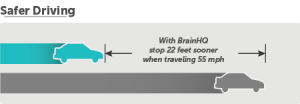 —particularly Double Decision—are great tools for assessing and improving driving safety. Among other things, these studies have shown that after training, drivers:
—particularly Double Decision—are great tools for assessing and improving driving safety. Among other things, these studies have shown that after training, drivers:
 Make 38% fewer dangerous driving maneuvers
Make 38% fewer dangerous driving maneuvers Can stop 22 feet sooner when driving 88 kilometers per hour (55 miles per hour)
Can stop 22 feet sooner when driving 88 kilometers per hour (55 miles per hour) Feel more confident driving in difficult conditions (at night, in bad weather, in new places
Feel more confident driving in difficult conditions (at night, in bad weather, in new places Cut their at-fault crash risk by 48%
Cut their at-fault crash risk by 48%
Balance and Gait
Did you know that when you fall or have another mobility issue, the fault is as much your brain’s as your body’s? That’s because balance relies on multiple cognitive and sensory systems, including the visual-spatial and visual-motor systems. BrainHQ’s visual training exercises are designed to improve these systems. To date, two studies have been conducted on balance and gait using BrainHQ exercises and assessments. These have shown that:
 Poor performance on a BrainHQ exercise correlates to a higher number of collisions and falls.
Poor performance on a BrainHQ exercise correlates to a higher number of collisions and falls. Using a set of BrainHQ exercises for 20–30 hours resulted in significantly higher scores on measures of balance and gait.
Using a set of BrainHQ exercises for 20–30 hours resulted in significantly higher scores on measures of balance and gait.






 English
English
 Français
Français
